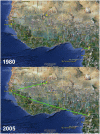HIV-1 molecular epidemiology in Guinea-Bissau, West Africa: origin, demography and migrations
- PMID: 21365013
- PMCID: PMC3041826
- DOI: 10.1371/journal.pone.0017025
HIV-1 molecular epidemiology in Guinea-Bissau, West Africa: origin, demography and migrations
Abstract
The HIV-1 epidemic in West Africa has been dominated by subtype A and the recombinant form CRF02_AG. Little is known about the origins and the evolutionary history of HIV-1 in this region. We employed Maximum likelihood and Bayesian methods in combination with temporal and spatial information to reconstruct the HIV-1 subtype distribution, demographic history and migration patterns over time in Guinea-Bissau, West Africa. We found that CRF02_AG and subsubtype A3 were the dominant forms of HIV-1 in Guinea-Bissau and that they were introduced into the country on at least six different occasions between 1976 and 1981. These estimates also corresponded well with the first reported HIV-1 cases in Guinea-Bissau. Migration analyses suggested that (1) the HIV-1 epidemic started in the capital Bissau and then dispersed into more rural areas, and (2) the epidemic in Guinea-Bissau was connected to both Cameroon and Mali. This is the first study that describes the HIV-1 molecular epidemiology in a West African country by combining the results of subtype distribution with analyses of epidemic origin and epidemiological linkage between locations. The multiple introductions of HIV-1 into Guinea-Bissau, during a short time-period of five years, coincided with and were likely influenced by the major immigration wave into the country that followed the end of the independence war (1963-1974).
Conflict of interest statement
Figures






References
Publication types
MeSH terms
Associated data
- Actions
- Actions
- Actions
- Actions
- Actions
- Actions
- Actions
- Actions
- Actions
- Actions
- Actions
- Actions
- Actions
- Actions
- Actions
- Actions
- Actions
- Actions
- Actions
- Actions
- Actions
- Actions
- Actions
- Actions
- Actions
- Actions
- Actions
- Actions
- Actions
- Actions
- Actions
- Actions
- Actions
- Actions
- Actions
- Actions
- Actions
- Actions
- Actions
- Actions
- Actions
- Actions
- Actions
- Actions
- Actions
- Actions
- Actions
- Actions
- Actions
- Actions
- Actions
- Actions
- Actions
- Actions
- Actions
- Actions
- Actions
- Actions
- Actions
- Actions
- Actions
- Actions
- Actions
- Actions
- Actions
- Actions
- Actions
- Actions
- Actions
- Actions
- Actions
- Actions
- Actions
- Actions
- Actions
- Actions
- Actions
- Actions
- Actions
- Actions
- Actions
- Actions
LinkOut - more resources
Full Text Sources
Medical
Molecular Biology Databases

